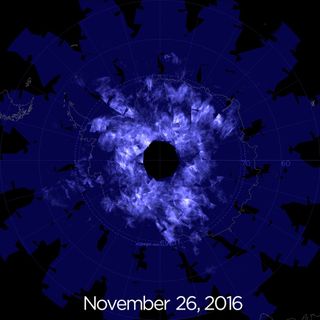Glowing Clouds Shine in Electric Blue Over Antarctica (Photos)

New images from NASA's Aeronomy of Ice in the Mesosphere (AIM) satellite mission show glowing, electric-blue clouds in the twilight sky over Antarctica.
These magnificent clouds — also known as noctilucent clouds, or NLCs — form in an upper layer of the Earth's atmosphere called the mesosphere, and can be seen in summer night skies from high latitudes. Data collected from AIM on Nov. 17 shows an early start to this year's noctilucent, or night-shining, cloud season in the Southern Hemisphere, according to a statement from NASA.
"This year, AIM saw the start of noctilucent cloud season on Nov. 17, 2016 — tying with the earliest start yet in the AIM record of the Southern Hemisphere," NASA officials said in the statement. "Scientists say this corresponds to an earlier seasonal change at lower altitudes. Winter-to-summer changes in the Antarctic lower atmosphere sparked a complex series of responses throughout the atmosphere, one of which is an earlier noctilucent cloud season." [Noctilucent Clouds Got an Early Start in 2013 (Video)]
Noctilucent clouds are Earth's highest clouds, as they take shape in the mesosphere, which lies about 50 to 53 miles (80 to 85 kilometers) above the planet's surface. The clouds form when water molecules cling to fine atmospheric debris (such as dust or remnants of disintegrating meteors) and freeze to form ice crystals. The mesosphere is the coldest layer of Earth's atmosphere, with temperatures averaging about minus 130 degrees Fahrenheit (minus 90 Celsius).
Since these clouds form at such high altitudes, they reflect light even after the sun has dipped below the horizon. Noctilucent clouds are generally seen during the summer in both the Northern and Southern Hemispheres, when the mesosphere is most humid from water vapor. The summer is also when the mesosphere is the coldest, with temperatures dropping as low as minus 210 degrees F (minus 134 C), largely due to seasonal airflow patterns, NASA officials said.

AIM launched in 2007 on a dedicated mission to study night-shining clouds and the mesosphere. Data collected from the mission has shown that the noctilucent cloud season can start anytime between Nov. 17 and Dec. 16 in the Southern Hemisphere.
In addition to studying these mystifying clouds, the AIM mission — operated by NASA's Goddard Space Flight Center in Maryland — strives to help scientists better understand the connection between the mesosphere and other parts of the atmosphere, weather and climate.
Get the Space.com Newsletter
Breaking space news, the latest updates on rocket launches, skywatching events and more!
"AIM data has shown us that changes in one region of the atmosphere can effect responses in another distinct, and sometimes distant, region," NASA officials said in the statement. "Scientists call these relationships atmospheric teleconnections. Now, due to natural precession, the (AIM) spacecraft's orbit is evolving, allowing the measurement of atmospheric gravity waves that could be contributing to the teleconnections."
Follow Samantha Mathewson @Sam_Ashley13. Follow us @Spacedotcom, Facebook and Google+. Original article on Space.com.
Join our Space Forums to keep talking space on the latest missions, night sky and more! And if you have a news tip, correction or comment, let us know at: community@space.com.

Samantha Mathewson joined Space.com as an intern in the summer of 2016. She received a B.A. in Journalism and Environmental Science at the University of New Haven, in Connecticut. Previously, her work has been published in Nature World News. When not writing or reading about science, Samantha enjoys traveling to new places and taking photos! You can follow her on Twitter @Sam_Ashley13.
